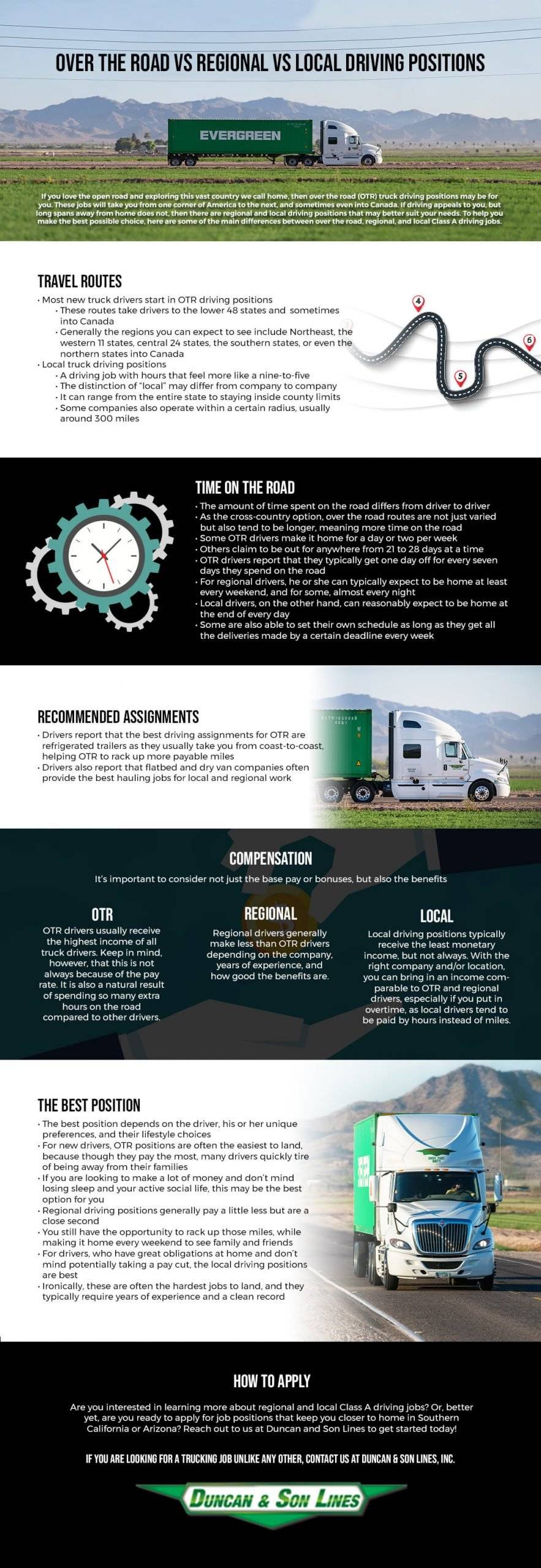
If you love the open road and exploring this vast country we call home, then over-the-road (OTR) truck driving positions may be for you. These jobs will take you from one corner of America to the next, and sometimes even into Canada. If driving appeals to you, but long spans away from home does not, then there are regional and local driving positions that may better suit your needs. To help you make the best possible choice, here are some of the main differences between over-the-road, regional, and local Class A driving jobs.
Travel Routes
The main difference between the three main types of driving positions is the route the drivers follow. Most new truck drivers start in OTR driving positions. The routes assigned to these positions take drivers to the lower 48 states and sometimes into Canada. Regional driving positions usually appeal to drivers who want to corner off a section of the geographical market that they enjoy working in, or who don’t like to venture too far from home.
The exact region will differ per company or distributor, but generally the regions you can expect to see include Northeast, the western 11 states, central 24 states, the southern states, or even the northern states into Canada.
For the drivers who prefer a driving job with hours that feel more like a nine-to-five setup, there are local truck driving positions available. The distinction of “local” may differ from company to company and can range from the entire state to staying inside county limits. Some companies also operate within a certain radius, usually around 300 miles.
Time on the Road
As a direct result of varying routes, the amount of time spent on the road differs from driver to driver. As the cross-country option, over-the-road routes are not just varied but also tend to be longer, meaning more time on the road. Some OTR drivers make it home for a day or two per week, but others claim to be out for anywhere from 21 to 28 days at a time. More time on the road then translates to less time at home with family and friends.
OTR drivers report that they typically get one day off for every seven days they spend on the road. For regional drivers, depending on how wide a region a driver operates in, he or she can typically expect to be home at least every weekend, and for some, almost every night. This translates into more time at home with family and friends.
Local drivers, on the other hand, can reasonably expect to be home at the end of every day or overnight shift and are typically home for the weekend or other assigned weekly days off. Some are also able to set their own schedule as long as they get all the deliveries made by a certain deadline every week.
Recommended Assignments
Drivers report that the best driving assignments for OTR are refrigerated trailers, as they usually take you from coast to coast, helping OTR to rack up more payable miles. Drivers also report that flatbed and dry van companies often provide the best hauling jobs for local and regional work.
Compensation
When looking at compensation, it’s important to consider not just the base pay or bonuses, but also the benefits. That said, as a direct result of all the great sacrifices made by OTR drivers, they usually receive the highest income of all truck drivers. Keep in mind, however, that this is not always because of the pay rate. It is also a natural result of spending so many extra hours on the road compared to other drivers. Regional drivers generally make less than OTR drivers. However, this depends on the company, years of experience, and how good the benefits are that come with the job. Local driving positions typically receive the least monetary income of all three driver types, but not always. If you find the right company and/or drive in the right area, you can bring in an income comparable to OTR and regional drivers, especially if you put in overtime, as local drivers tend to be paid by hours instead of miles.
The Best Position
After successfully completing CDL classes, many drivers wonder what truck driving jobs are best for them. However, that depends on the driver, his or her unique preferences, and their lifestyle choices. For new drivers, OTR positions are often the easiest to land, because though they pay the most, many drivers quickly tire of being away from their families. However, if you are looking to make a lot of money and don’t mind losing sleep and your active social life, this may be the best option for you. Regional driving positions generally pay a little less but are a close second. You still have the opportunity to rack up those miles, while making it home every weekend to see family and friends. For drivers, who have great obligations at home and don’t mind potentially taking a pay cut, the local driving positions are best. Ironically, these are often the hardest jobs to land, and they typically require years of experience and a clean record.
Find a Rewarding Trucking Career at Phoenix Trucking Jobs!
Are you interested in learning more about regional and local Class A driving jobs? Or, better yet, are you ready to apply for job positions that keep you closer to home in Arizona? Reach out to us at Duncan and Son Lines, Inc. to get started today!

